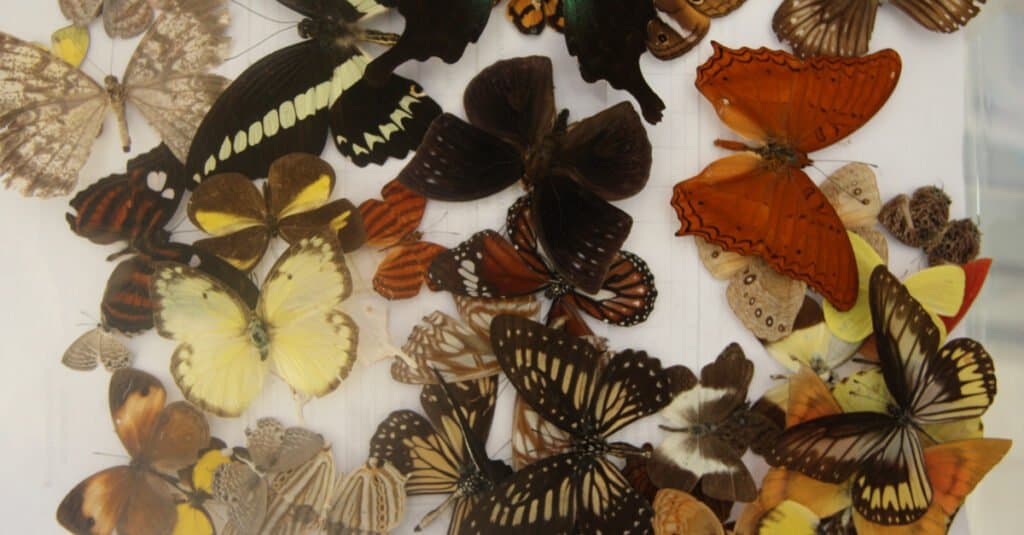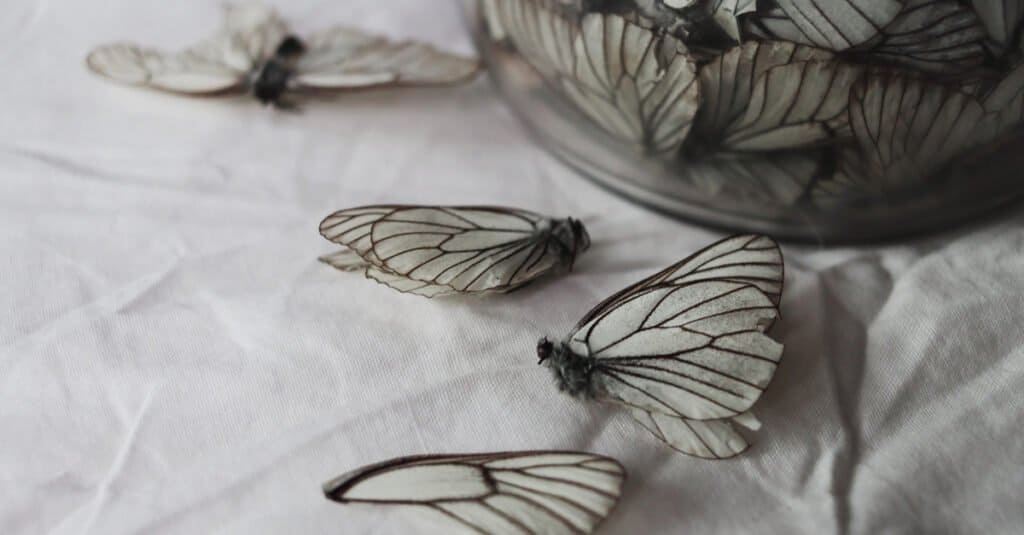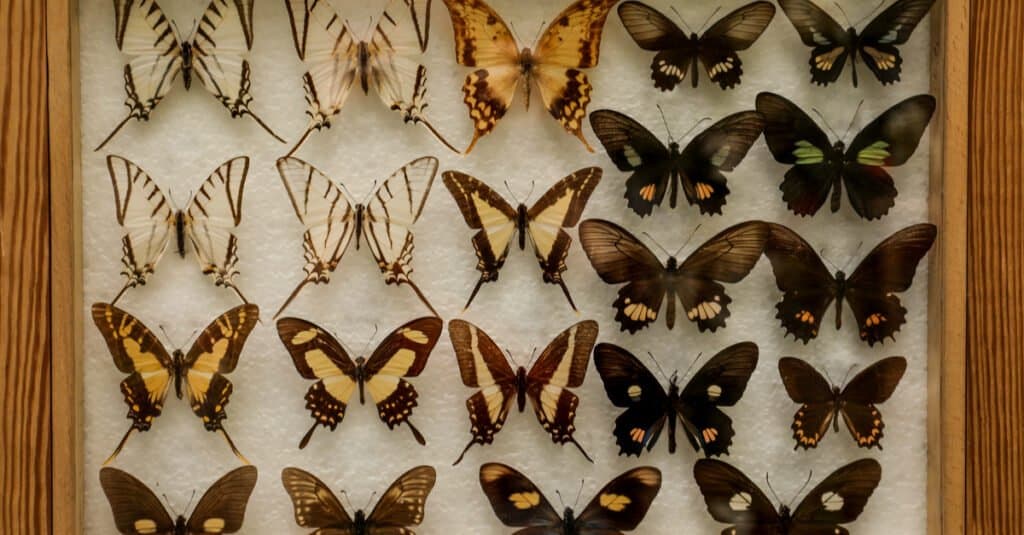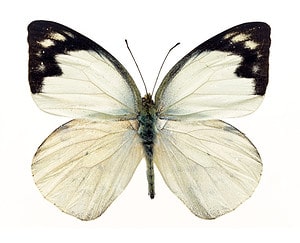The butterfly is easily considered to be one of the most beautiful creatures by children and adults alike. Luckily, insects can be kept after they’re dead, and the butterfly is no exception.
Whether you want to display it in a jar, in resin, in a shadowbox, or mount it on a board or in a frame, you need to know how to keep a dead butterfly from disintegrating. Here are six simple steps on how to preserve a butterfly for collecting, mounting, and otherwise keeping so it will last for years to come.
Read on to learn how to preserve a butterfly.
Step 1: Choose a Butterfly

©HASIHOLAN SIAHAAN/Shutterstock.com
We don’t recommend collecting butterflies by killing them for art purposes. Collecting a butterfly ideally involves finding a dead butterfly outside. But if you can’t, and you have a certain species in mind, your best option is to purchase a caterpillar from a butterfly farm.
You’ll be able to watch as it turns into a pupa into a butterfly. Once it dies of natural causes, you’ll have your butterfly specimen, and you can put it into an envelope with mothballs until you are ready to start mounting it.
Step 2: Get Supplies
You’re going to need specific tools for handling the butterfly for collecting, mounting, and display purposes:
- Dress, straight, or insect pins. Insect pins should be a size two
- A piece of styrofoam or a spreading board that is bigger than the butterfly
- Wax or tracing paper
- Forceps
- A glue gun
- Airtight glass jar or plastic container with a lid, and a window screen, wire mesh, or aluminum foil for the bottom
- Paper towels and antiseptic (such as Lysol or Pine-sol)
Step 3: Relax the Butterfly

©cuttingtool/Shutterstock.com
The next step is to relax the butterfly for positioning. If your butterfly has been dead a few days, it’s going to be rigid. But if it has recently died and you won’t work on it for a few days, stick it in the freezer. When you take it out, you can help keep it fresh and keep dust off with hairspray. Otherwise, skip this step.
To relax the butterfly, start by putting a couple of paper towels in a jar and adding a few drops of antiseptic, which will prevent mold growth. Put the window screen, wire mesh, or piece of aluminum foil on top, followed by the butterfly and the lid.
It should normally take no more than one or two days for it to relax, but if you can’t move its wings you might need three to four days. Check every day to know when it’s relaxed enough and make sure it’s dried out. Once it is ready, you can keep the colorful scales on and dust off with hairspray.
Step 4: Mount the Butterfly with Pins
The next step is to mount the butterfly with pins to position it just right for your display. Cover the piece of styrofoam or the spreading board with wax or tracing paper, either a single piece or one piece for each wing to not rub off the scales, and hold the paper in place with pins on the corners.
Use the forceps to gently put the butterfly on it, then use pins to keep the butterfly still by putting them on both sides of the abdomen between each wing and the abdomen, and then between each wing and the thorax. You can also push a pin in the middle of the thorax if it’s still moving.
Now you are ready to work on each wing by first placing a piece of wax or tracing paper over the opposite wing to protect the scales from your hand. Use a pin on the forewing and gently push on the large vein running along the top margin until the forewing is evenly perpendicular to the body, then place the paper over it.
Start pinning the paper as close to the wing as possible. When you’re ready to work on the hindwing, use a pin to push the bottom of the paper out of the way. Do the same manipulation and pinning for the hindwing and then the other side of the butterfly.
The last step is to pin the antennae, which is standard practice to pin into a v-shape. Use the pins to straighten them out and put them as close as possible into the v-shape. Once you’re all done, you’ll want to wait at least 48 hours but up to six days for the butterfly to completely dry and remain frozen in position. Remove the pins and paper, and you’re ready to display your butterfly.
Step 5: Display the Butterfly

©New Africa/Shutterstock.com
There are several ways to put your butterfly on display. Regardless of the one you choose, you’ll want to set your butterfly away from direct sunlight and in a cool, dry place:
In a Jar, Glass Dome, Vial, or Double-Glass Frame
This display method is simple and doesn’t need any pins. Just make sure it is large enough to hold the butterfly. You’ll also want to use a preservative fluid such as alcohol for the vial. For the glass dome, glue the butterfly onto a stem or a piece of wood and arrange it with other dried materials and then glue the glass dome onto the base with clear silicone glue or epoxy glue. For the double-glass frame, you can either use clear silicone glue to glue the butterfly onto the glass or glue or pin it onto a piece of cork which you’ll then glue onto the glass.
In a Specimen Drawer
A specimen drawer is a large, wooden display case with styrofoam inside and a glass cover. It is something of an investment, but if you want to display several butterfly specimens, this is a great option.
Some of these specialized wooden cases are designed to keep butterflies preserved for as along as possible. They keep out other insects, dust, and other natural elements to stop the butterflies from degrading over time. Cases can be found online, however, they can be expensive.
In Wrecker Mount
Available at craft stores, a wrecker mount allows you to display your butterfly in a frame with cotton wool backing, a glass cover, and side opening pins. It is affordable and keeps the butterfly in place without the need for any pins.
In a Shadowbox
A shadowbox is another method where you can display your butterfly in a frame. It is available at several craft and retail stores. You don’t need pins for this, either, and you need to do is to glue the butterfly to a glue stick, which is clear and won’t be obvious. Alternately, you can get a different type of storage box, such as a Schmidtt box, Cornell drawer, cabinet, or even a cigar box with styrofoam or cork backing.
In Resin
For this method, you’ll need clear casting resin, rubber molds, and a silicone mat, which you can buy from a craft store. The resin comes with a catalyst (hardener) to make it set, which is toxic, so you’ll also need disposable gloves. This method needs experimentation to center the butterfly, remove air bubbles and properly cure the resin. The rubber molds should be one to two inches larger than the butterfly’s wingspan.
First, you must mix well the resin and the catalyst. Then, you’ll slowly pour a thin base layer into the mold. Use spade-tip forceps to partially submerge the butterfly into it, and let the resin dry for at least 15-20 minutes, more if necessary – long enough for it to gel but not harden while also not allowing the butterfly to move.
You’ll then add another layer of resin or two if your butterfly can still be moved after each extra layer. Let the resin cure for three days before popping it out of the mold, ideally at a temperature of 75 to 85 degrees Fahrenheit or near a space heater. Once it’s done curing and out of the mold, you can sand it and optionally add a coating of clear plastic spray.
Step 6: Do Pest Control
Your butterfly is now on display, and you have to maintain its beauty to make all that work worthwhile. Pest control will keep away other insects from destroying it if you are storing it in the dark. You can do this with mothballs, paradichlorobenzene crystals (or another pesticide), fumigant strips, or cedar planks. Note that mothballs will melt the styrofoam. If you are storing the butterfly in a container that allows dust in, you can keep the dust off with hairspray.
Now that you’re familiar with how to preserve a butterfly in six easy steps, you know how to make it into a beautiful piece of art in a jar, in a frame, in a shadowbox, in resin, or any other option. Decide on what display option is best for you, or experiment with different techniques to preserve it. If you follow these steps correctly, your butterfly is sure to stay intact, clean, and bright for a long time.
How Long Can a Butterfly Survive in a Jar?
If you happen upon live butterflies and want to keep them as pets, think again. The best environment for butterflies to thrive and live their already short lives is in the wild. A butterfly in a jar will only last a few days, and a butterfly kept in a cage may last up to 2 weeks. In either case, if you want to keep butterflies, provide them with sticks arranged tilted and upright in the cage or jar. Jar lids must be punctured to create air holes, or a section of a nylon stocking secured over the top with a rubber band works great as a lid. Next, provide a food source. Make a sugar water solution that is 3 tsp. of sugar dissolved in 1 cup of water. Store in the refrigerator. This can be added with a dropper to cotton balls or flowers. You may also put freshly sliced pieces of fruit, such as cantaloupe and apples, in their habitat. Add sugar water to these as well.
The photo featured at the top of this post is © Cristina Conti/Shutterstock.com
Thank you for reading! Have some feedback for us? Contact the AZ Animals editorial team.






